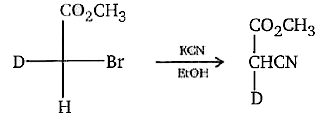If the total enthalpy of reactants and products is HRandHP respectively, then for exothermic reaction
HR=HP
HR<HP
HR>HP
HP≥HR
The correct Answer is:C
To solve the problem regarding the enthalpy change in an exothermic reaction, we will follow these steps:
Step 1: Understand the Definition of Enthalpy Change
The enthalpy change (ΔH) for a reaction is defined as the difference between the total enthalpy of the products (HP) and the total enthalpy of the reactants (HR). Mathematically, this is represented as:
ΔH=HP−HR
Step 2: Identify the Nature of the Reaction
In an exothermic reaction, heat is released into the surroundings. This means that the enthalpy of the products is lower than that of the reactants. Therefore, for an exothermic reaction, ΔH is negative.
Step 3: Set Up the Inequality for Exothermic Reactions
Since we established that ΔH is negative for exothermic reactions, we can set up the inequality:
HP−HR<0
Step 4: Rearrange the Inequality
Rearranging the inequality gives us:
HR>HP
This indicates that the total enthalpy of the reactants (HR) is greater than that of the products (HP).
Step 5: Conclusion
Thus, for an exothermic reaction, the correct statement is:
HR>HP
Final Answer
The correct option is that the total enthalpy of reactants (HR) is greater than the total enthalpy of products (HP).
---
The enthalpy change (ΔH) for a reaction is defined as the difference between the total enthalpy of the products (HP) and the total enthalpy of the reactants (HR). Mathematically, this is represented as:
In an exothermic reaction, heat is released into the surroundings. This means that the enthalpy of the products is lower than that of the reactants. Therefore, for an exothermic reaction, ΔH is negative.
Since we established that ΔH is negative for exothermic reactions, we can set up the inequality:
Rearranging the inequality gives us:
Thus, for an exothermic reaction, the correct statement is:
The correct option is that the total enthalpy of reactants (HR) is greater than the total enthalpy of products (HP).
Topper's Solved these Questions
- THERMODYNAMICSBOOK - AAKASH INSTITUTE ENGLISHCHAPTER - THERMODYNAMICSEXERCISE - SECTION-B
20 Videos
- THERMODYNAMICSBOOK - AAKASH INSTITUTE ENGLISHCHAPTER - THERMODYNAMICSEXERCISE - SECTION-C
13 Videos
- THERMODYNAMICSBOOK - AAKASH INSTITUTE ENGLISHCHAPTER - THERMODYNAMICSEXERCISE - TRY YOURSELF
66 Videos
- THE SOLID STATE BOOK - AAKASH INSTITUTE ENGLISHCHAPTER - THE SOLID STATE EXERCISE - Assignment (SECTION - D) (ASSERTION-REASON TYPE QUESTION)
20 Videos
Similar Questions
Knowledge Check
The configurations of the reactant and the product in the following reaction, respectively, are
 AR,RBR,SCS,RDS,S
AR,RBR,SCS,RDS,S
In a reaction, all reactant and products are liquid, then
View SolutionIn an endothermic reaction, the total enthalpy of products is greater than that of reactants.
View SolutionAssertion (A) : In the reaction, N2+3H2→2NH3, the rate of reaction is different in terms of N2,H2 and NH3.
Reason (R ): The rate of reaction is equal to the rate of disappearance of a reactant or rate of formation of a Product.
View SolutionThe ΔrH∘ (enthalpy of formation) is positive in :
View SolutionIf the end energies of H-H, Br-Br and H-Br are 433, 192 and 364 kJ mol−1 respectively, then ΔH∘ for the reaction, H2(g)+Br2(g)→2HBr(g) is
View SolutionIn an exothermic reaction, the total enthalpy of reactant is ………….than that of products.
View SolutionIn an exothermic reaction, the total enthalpy of products is greater than that of reactants.
View Solution
